While keeping the information on this website as objective as possible, I thought it would be nice to tell about my own personal experiences with certain apple snail species. So keep in mind that the information within this page is -not- based on scientific articles, but a reflection of the author's opinions and experiences. If you do not agree with things described on this page, or on the opposite: you have had similar experiences, I'll be glad if you let me know (click here).
Pomacea diffusa
|
|
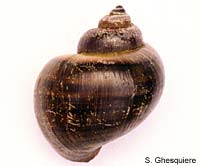 Shell of a dark wild-form Pomacea diffusa (bridgesii) snail, back view. |
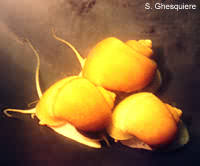 Pomacea diffusa yellow (golden) variant. Note the flat top of the whorls. |
Pomacea diffusa is
the apple snail I started with when I bought 2 yellow snails in the fall of
1997. At that time I had no idea what and how about apple snails. I even wasn't
aware that I bought a pigment lacking variety of this apple snail (the natural
form is almost black).
Anyway, these snails are relatively easy to keep in captivity. They do not eat
aquarium plants and hardly eat any lettuce. To keep them healthy I feed them
fish food and sometimes a slice of cucumber. They produce eggs
all year round with a peak in spring (March-April) and a winter stop (October-December).
The eggs are closely attached to each other and the little snails appear after
2-3 weeks, although it can take even 3-4 weeks at lower temperatures. Once the
little snails arrive, the difficulty with this snail species comes clear: the
first weeks are hard for them. At least in my case. But after a while I noticed
that the best way to raise these snails is by keeping the young in the same
tank as the parents. It also helps to -not- clean the tank too well. Apparently
the baby diffusa snails
eat waste from the tank sides.
Temperature is not a hot topic with my Pomacea diffusa
(bridgesii) snails as long as I keep the temperature
above 18°C. They become completely inactive at lower temperatures and eventually
die if the temperature is maintained low.
Pomacea diffusa snails
can at least live for about 2-3 years and maybe older. I noticed vanishing of
their smooth shell surface when they grow
older. Snails that are over 1 year gradually loose the surface layer of their
shell, which results in a colour loss as the colourless calcium
layers of the shell become visible. Also, these snails become less active
over time and their tentacles and
foot becomes a bit swollen. It
appears to me that these snails get problems with their osmotic regulation when
they get old, which results in a fluid excess in the tissues.
My Pomacea diffusa snails
are not very active during the day (the adults always reside on the bottom,
while the juveniles mostly reside near the water surface). Their activity levels
drop dramatically during the winter months here in Europe. The temperature does
not decrease very much, but somehow enough for them start a kind of hibernation.
Interesting feature of this species are the many colour varieties that are available:
yellow shell with yellow body; yellow shell with dark body, dark shell with
dark body, dark shell with yellow body, white shell with yellow body and blue
shell with dark body. All these colour varieties are the results of the availability
or lack of certain pigments. Crossbreeding these varieties is very interesting!
Pomacea canaliculata
|
|
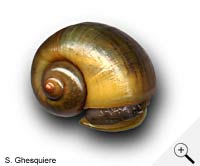 Typical deep, indented sutures of Pomacea canaliculata. |
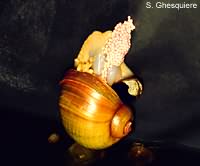 Female depositing eggs (Pomacea canaliculata). |
Pomacea canaliculata
is the second apple snail species I got in my tank.
At the time I bought these snails, I still had no clue about the existence of
several species, but I quickly found out when I compared my new snails with
the ones I already had (Pomacea diffusa
(bridgesii)). This triggered me to collect more information.
One of the first things I noticed with these interesting snails is the deep
suture and the orange eggs.
And at the same time these snails made me clear why apple snails can be a real
threat to rice fields and to the nice collections of water plants of many aquariist.
While the Pomacea diffusa snails left my plants alone, the Pomacea canaliculata
ate away my tank vegetation within a week.
Pomacea canaliculata is also a very easy snail to keep. It's less temperature
sensitive than Pomacea diffusa
(better resistant to lower temperatures) and these snails ate almost
everything.
Egg production is not an all
year round event. They only reproduce
in the winter and spring (October-May). They eggs are bright orange and loosely
attached to each other. The baby snails are much easier to raise then the Pomacea
diffusa snails
(they immediately do well on lettuce and other vegetables). The growth speed
of these snails is remarkable: after 1/2 year they are about 4-5 cm diameter
when the condition are good (high temperature, good water quality and 'lots'
of food).
Although these snails are not known as very large apple snails (about 5-6 cm
average) they can get huge if they are fed all the time (ad libido) (6-8 cm
shell height). This is much bigger then the Pomacea diffusa
(bridgesii) snails ever (around 5cm height max).
I do have some colour varieties, but these are less spectacular then the Pomacea
diffusa snails.
At the moment I have some yellow ones (the golden apple snails), a bunch of
dark brown ones and some intermediates (green, dark and light body). In fact
I bought some dark snails in one shop and yellow ones in another and got the
in between variations by crossbreeding them.
In my own snail population, these snails tend to get older than my diffusa
snails do. My oldest one at the time of this writing is about 3 years old and
still doing well. Also these snails do not suffer from severe shell
detoriation as my diffusa snails do when getting older.
Marisa cornuarietis
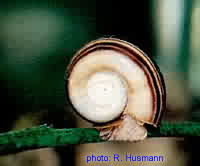 Marisa cornuarietis. |
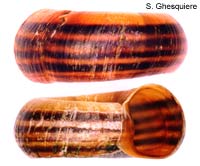 Marisa cornuarietis shell. |
|
|
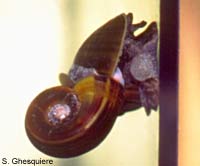 Marisa cornuarietis is not selective when it comes to a mating partner and mounts other species as well (in this case a Pomacea flagellata snail). |
Marisa cornuarietis
is easy to recognise due to its flat shell shape. It's often called the Colombian
ramshorn or the Giant ramshorn.
Renate Husmann was so kind to send my a whole collection of these snails (thanks!)
by mail. Besides the natural striped snails, she also provided my with an interesting
variety that lack the dark stripes on the shell.
From day one, these snails never gave me any problems
as long as the temperature stays above 20°C. They are less capable of surviving
in colder temperatures than my other apple snail species are. Not strange as
one realises that these snails are real tropical animals, whereas for example
Pomacea canaliculata
is rather sub-tropical.
Besides their shell shape, these snails differ
from many other Ampullarid snails by the
fact that they deposit their eggs
in a gel-like substance in the water. Because the eggs are transparent, one
can look at the developing snails inside the eggs. What's even more, you can
see the little snails walk
around inside the eggs, especially in the last days before hatching starts.
Also interesting to see is how the eggs swell over time until the little snails
walks inside a thing bubble of around 5mm diameter.
Just like Pomacea canaliculata,
these snails eat nearly everything that is somewhat digestible and not fast
enough to escape from them.
The most exiting experience I had with these snails was an sinistral
specimen I noticed one day. In this case, the snail was left-turned instead
of having a normal right-turned shell. Better said: this snails was a mirrored
version of its siblings. Sadly enough, this snail died after a few months, so
I never had the chance to see if I could get this snail to reproduce and what
the effect would have been on their offspring.
Like the Pomacea diffusa
snails, these snails also tend to have severe shell
detoriation when growing older. Luckily, at the other hand, the snails mostly
manage to enforce their inner layers;
so complete shell disappearance does not occur.
When it comes to reproduction, marisa
males are apparantly not very selective in their selection for a snail to mate
with. In my case, the marisa
snails mount the Pomacea diffusa
(bridgesii) snails as well the Pomacea
flagellata snails.
Pomacea flagellata erogata:
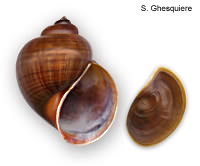 Flagellata erogata, shell from underside. |
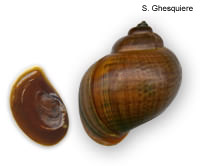 Flagellata erogata, shell, back view. |
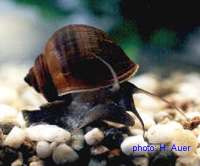 Live specimen (from Palenque, Mexico), subspecies erogata (Fisher & Crosse, 1890). |
This interesting apple snails species was send to me by Harald Auer (thanks!), in early 1999. The snails I got where the second generation of snails caugth in Palenque, Mexico. It was a hard time to determine these snails, but finally I managed to do so based on their shape, colour and geographic location. While Harald had good results with these apple snails, mine did not do very well. Although they did grow well at fist, they stopped growing after a while and became gradually less active. One after another died and despite the fact that I got a second batch in August 1999, I did not manage to keep these snails alive, let alone to get them reproducing. In summer 2000, my last one died. Harald reported similar problems as well. For some reason, it's hard to keep these snails in captivity. Maybe they have need for very specific needs to remain healthy.
Pomacea flagellata flagellata:
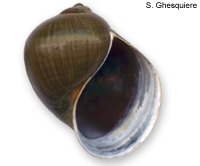 Flagellata flagellata, shell from underside. |
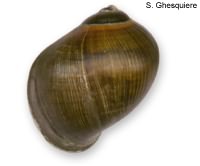 Flagellata flagellata, shell from above (from Balneario, Teuchitlan, Mexico). |
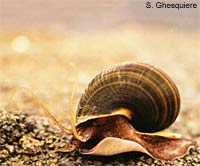 Flagellata flagellata, walking around. |
I acquired this Mexican snail species in January 2000 from Brian Kabbes (thanks!).
The beauty of these snails immediately attracted me: their dark shell
with smooth surface. I believe they are amongst the more beautiful apple snail
species (in my own opinion at least).
The snails grow quickly and around summer 2000 I got my first egg
clutches. These eggs are indistinguishable from the Pomacea diffusa
(bridgesii) eggs. The eggs hatched within 2-3 weeks and after a while
I had a large pool of Pomacea flagellata
flagellata snails. This was a big difference from what I had experienced
with the Pomacea flagellata erogata
I had before.
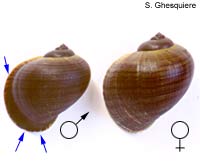 Sex differences in adult Pomacea flagellata flagellata snails. The female is larger and has a straight shell opening, while the male (left) has a extended shell lip. |
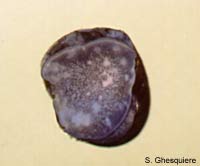 A Pomacea flagellata with white spots on the foot and body. These lesions expand at the border and slowly heal somewhat in the center. In the case of the author's snails, many affected snails died. |
If one asked me to tell something remarkable about these snails, I would mention
the striking sex difference between
the male and the female
snails. More specifically the male has a trumpet like shell opening, which is
absent in the female. I haven't read any article yet that mentions this obvious
difference, although a sex difference has been reported in Pomacea canaliculata,
although less visible (only a rounder shell opening in the male snail).
Despite the good start I had with this species, after a while I noticed small
white spots on the foot of these
snails. These small white patches look like scar tissue and slowly progress.
In severe cases, the snails appear to die from this condition. I still have
no clue what the cause could be. I've tried to play with the temperature,
I switched food and raised and lowered the pH,
but these snails keep developing these discoloured regions on their foot and
other places of their body. As the other snail species do not get these patches,
I gives me the impression I'm dealing with a deficiency in their tank habitat
rather than a parasite or another microorganism. On other words: something is
missing, but what? Hopefully I manage to get a thirth generation, which hopefully
has less problems and maybe I can get rid of this white path disease due to
selection of the more resistant snails. We'll see.
February 2001: Things seem to get better. The white patches on the snails disappear
somewhat and some snails have almost no spots. They grow well again and I expect
them to reproduce within months.
April 2001: Snails are going fairly well. I do expect eggs within the next months
:)
Update 2007: These snails did not survive.
Asolene (Asolene) spixi
|
|
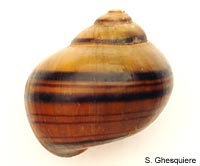 Same snail, back view. |
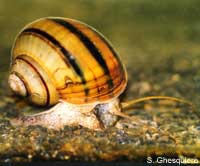 Asolene (Asolene) spixi. |
Around October 2000 a snail package arrived from Brazil. To my great happiness,
it contained 3 Asolene spixi
and 2 Asolene (Pomella) megastoma
snails, alive! (Thanks Fabio!).
The spixi snails have
(in my opinion) a very beautiful striped shell.
The base colour and the sharp stripes give the a resemblance somewhat comparable
with Marisa cornuarietis.
And suprisingly enough, the Marisa snails
thought the same as some males
mount the spixi snails. :)
Anyway, the spixi snails are not amongst my most active snails. Nevertheless
they eat reasonably well. When they walk
over smooth surfaces they exhibit a strange way of walking: they extent and
contract their foot, which makes their walk step-like. They haven't grown much
since I got them (less then 1/2 cm shell addition near the shell opening in
3 months).
Good news: the snails started to mate in March 2001 and deposited eggs in April,
which have hatched now in May.
The eggs are indistinguishable from Marisa cornuarietis
eggs.
Asolene (Pomella) megastoma
|
|
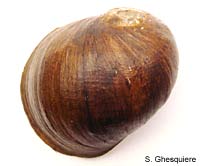 Same snail, back view. |
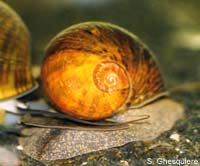 Asolene (Pomella) megastoma. |
Together with the Asolene (Asolene) spixi
snails, 2 Asolene (Pomella) megastoma
snails arrived. It was the first time I saw these snails alive. I did had some
specimens in formaline, but no living snails.
What I like most in these snails is their unusual shell
shape: very broad shell opening (aperture), with a flat shell spine.
Furthermore they have a large head, with the tentacles
far apart. Their eyes are on the small
size and are visible as tiny black spots on top of the eyestalk.
They walk slowly and keep their
head constantly beneath their shell. In fact, you'll only see their tentacles
and part of the proboscis (snout).
And while my Asolene spixi
snails only grow very slowly, the megastoma
snails are fast growing snails. Not surprisingly if one keeps in mind that my
snails were only 3 cm in shell height, while they can easily grow to about 10
cm height. In other words, my snails are juveniles (young snails).
I hope that my two megastoma
snails are of different sex, so I
can get some babies in the future (as I would like to see in all my snails).
Until now, these snails did not give any problems and appear to be easy snails
to keep. But time will tell...
Update 2007: These snail eventually died, without offspring.
Pomacea maculata; Corrected to Pomacea haustrum.
|
|
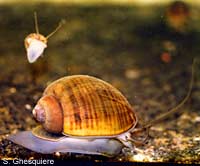 Pomacea haustrum. |
In August 2000 I finally managed to get some Giant apple snails (Pomacea
maculata) mailed to me by
Sandra Shumilla (Thanks!).
One of the first things I noticed when I saw these snails for the first time,
was their resemblance to Pomacea canaliculata,
but somehow they were different in some ways as well. The shell of my 10 small
maculata snails was higher then a canaliculata
of same size. They look somewhat like a stretched canaliculata, with less deep
sutures and a less rounded appearance. Sandra also mentioned the green colour
of their eggs instead of the orange eggs of canaliculata. Besides the
difference in shell shape, these snails also
have a longer siphon, especially
visible when the snails have their siphon at rest. In a canaliculata
snails, the siphon is very short when not in use and eventually opens up to
a be no more than a mantle
fold. In maculata, however,
the siphon is folded in front of the foot
when not in use.
The snails I got in August 2000 grew very fast since that time. Their size increased
from 2-3 cm height to 6-7 cm in 5 months.
Although their appetite is less extreme than in Pomacea canaliculata
snails they are good eaters of all kind of vegetation.
April 2001: I have my doubts whether these snails are Pomacea maculata
as they could well be Pomacea haustrum
as well. It's rather hard to tell the species without knowing where they originally
come from... I need to get some more info and/or wait until the snails are fully-grown.
I do know at least that Pomacea haustrum
does not grow above 12 cm shell height.
Juli 2001: I'm getting more and more convinced that these snails are not maculata
but haustrum. This because: 1. the colour resembles haustrum much
more than maculata; 2. Haustrum has green eggs as well; 3. Haustrum
has been reported in Florida, brought there with the aquarium trade, while maculata
has not been reported yet. 4. Their growth slows downs and they show sign of
getting ready for reproduction, while they are about 8-9 cm at the moment.
Update 2007: After we moved to Belgium in 2001, the haustrum population declined
and around summer 2001 I had none left.
|
Except where otherwise noted, this page is licensed under a Creative Commons Attribution-NonCommercial-ShareAlike 2.5 License . http://www.applesnail.net |
|